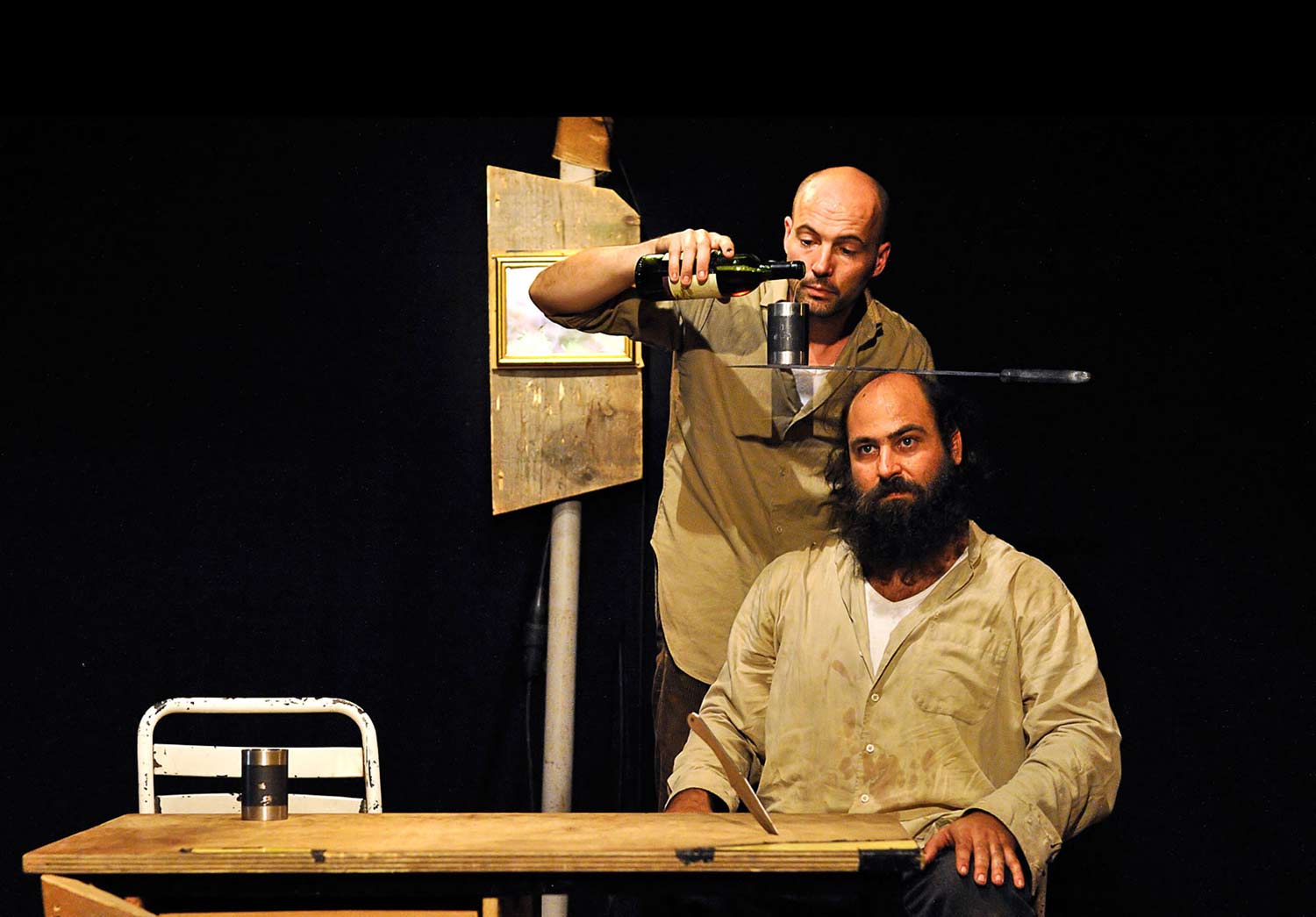Marée basse – low tide. Downtime. The waiting time.
On stage, there’s a house, or at least, a kind of shack. Inside its wooden boundaries, a kitchen table, a couple of chairs, a small enamel cooker, tin pots and pans, a TV. As we enter the auditorium, a nasty waspish synth line repeats and repeats ad nauseum. We sit down. We wait.
A stubbly bald man in a brown shirt and overcoat shuffles on, sits – or tries to, ending up painfully (for us if not for him) tangled up with the chair. Another man comes on, bulkier, fully bearded. He trips over the edge of the flooring, gets into a flap trying to locate an invisible hook for his coat, ends up sitting next to the other man. They sit, they wait, they pass the time, time passes. Who are what are they waiting for? Godot only knows.
It’s dinner time – kind of. There is a slow paring of an apple, a few slugs of wine, a rattled pot. Things turn freaky as knives are thrown. A great scary cleaver is stuck into the table. There is some rather clever business – Lazzi tricks and turns – as men and table and chairs and knives and metal mugs are thrown or balanced or juggled in unconventional ways. It is all about the game between these two, and we are observers but not recognised as present. There is no music, and no spoken text – just some grunts, and bangs, and popping corks. And most unnervingly, the sound of that meat cleaver as it connects to a great many different surfaces. I find myself shifting a little uneasily in my seat.
Just as I’m starting to feel a little bored – bang! The tussle intensifies and the thinner man ends up falling through the back curtain and off the wooden flooring of the shack, immediately alerting us to the fact that this is a theatrical setting. I wake up a little more, interested. He reappears in the auditorium – heralding the start of a new dimension to the piece. Now we are acknowledged, and played to. Two red waistcoats are brought out (inevitably, the big man’s waistcoat is too small for him). They stand outside the perimeter of their shack, fully downstage, and show us their acrobalance act – old-timers who are trying to relieve the glory days in vaudeville. The TV is switched back on to provide an unsuitably grandiose soundtrack. They are seeking our approval with ‘ta da’ endings and desperate puppy-dog eyes. The turning on and off of the TV – the blank blue screen, the white ‘snow’, sound or no sound – is a key element to the show, acting as a kind of scene-setter or marker. Eventually, they watch the TV and ignore us, other than for an occasional glance over the shoulder…
The clowning skill of the deviser-performers (Benjamin de Matteis and Mickael Le Guen) is beyond question – they trained at the Lido Circus School in Toulouse and the show bears the mark of that heritage. That Le Guen was, as a youth, an award-winning apprentice chef is no doubt a factor in the subject matter and setting of the show.
Marée Basse is a show that I enjoy rather than absolutely love. I feel a little unsure when watching it, rather unsettled, but appreciate it more and more afterwards, as I remember a small detail cleverly played – particularly the extraordinarily nerve-racking knife throwing and object balancing scenes – or muse on the relationship to the audience and to the performance space that is explored and acted out here. I believe it was originally devised for and performed in a tent, and I have the feeling that I would have enjoyed it more in this setting. From my seat on the end of an aisle a few rows back, I felt a little detached from the stage action.
Not my favourite ever clown show, but a good and interesting show by a pair of very talented performers.
Featured image (top) by Vincent d’Eaubonne

